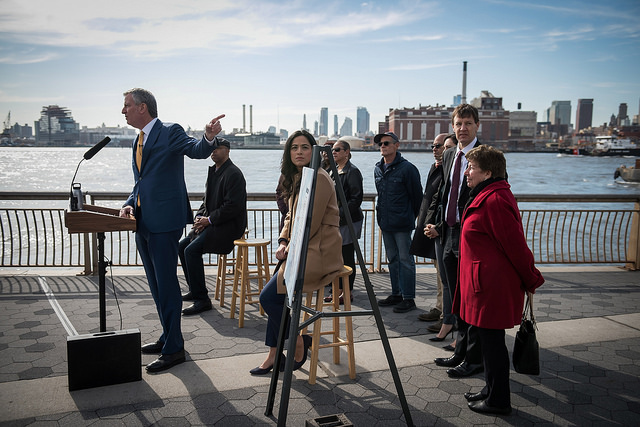NYC bus ridership is in free fall, and Mayor de Blasio, who manages the city's streets, has a lot of leverage to fix it. Unfortunately, de Blasio's transportation priorities lie elsewhere. You can tell by looking at where the money goes.
Announcing the construction of a new NYC ferry dock at Corlears Hook yesterday, de Blasio billed the ferry network as a solution to the city's transportation woes. "You can’t get opportunity in the modern world if there isn’t mass transit," he said. "We have to do a better job and we have to do new and different things and this is an example of it."
But we also have to do things that make good use of limited funds, and the city's $325 million investment in ferry-related capital construction, not to mention the $30 million annual outlay for operations, is hard to justify in light of the meager resources spent on bus and bike improvements that would serve many more New Yorkers.
Let's look at how far the ferry investment goes, and what the same amount of money could do if you spent it on bus or bike-share upgrades.
In 2017, the ferry carried about 2.89 million trips, or fewer than 10,000 per day. That's a little bit below the ridership on the Bx30, and New York City Transit operates 91 bus routes with more riders than the Bx30.
Under de Blasio, each year NYC DOT plans to add transit signal priority to a handful of bus routes and upgrade two routes to full Select Bus Service with bus lanes, off-board fare collection, and other enhancements.
What could DOT do if the administration invested in buses like it's investing in ferries?
The capital costs of Select Bus Service implementation average out to around $10 million per route, according to DOT [PDF]. There are no additional operating costs, not only because the city doesn't run the buses, but because SBS improvements make bus routes more efficient for the MTA to operate.
So if City Hall spent the $30 million going to ferry operations on SBS projects instead, it could more than double the pace of implementation, rolling out five routes a year instead of two. Add the $325 million in ferry capital costs, and you could implement a few more SBS routes every year for a decade, more than tripling the current pace.
The impact of bus upgrades would be far greater. On the B44 in Brooklyn, for example, a $15 million investment in dedicated bus lanes, transit signal priority, off-board fare payment, and bus bulbs yielded 15 to 30 percent faster service for 40,000 daily riders. SBS routes like the Bx12, Bx41, and M86 are some of the few major bus routes bucking the overall trend toward declining ridership.
A single SBS project can improve daily travel for tens of thousands of people -- more than the entire ferry network carries. And yet the city's annual commitment to expanding Select Bus Service is just $9.4 million, a third of its ferry operating expenses.
Bike-share also moves many more New Yorkers for less money than ferries. In January, the dead of winter, Citi Bike users made more than 700,000 trips, about three times the annual ferry ridership rate, with no capital or operating subsidy.
The cost of bike-share expansion has been pegged at $6,000 per bike, with operating subsidies expected to be negligible for a system up to four times the size of the current 12,000-bicycle Citi Bike network.
In other words, City Hall could quadruple the size of the bike-share system for $216 million -- far less than what it's spending on ferry dock construction and boats. At the current usage rate of five trips per bike per day, this larger bike-share network would dwarf the ridership that ferries get by a factor of 20.
But the de Blasio administration has shown little appetite for expanding bike-share, even passing on a deal with Citi Bike operator Motivate that would have grown the system 50 percent with zero public subsidy.
Bus improvements and bike-share stations may be cost-effective transportation investments that help large numbers of people get around compared to ferries. But you need to claim space from motor vehicle traffic to make a bus lane, and the best way to expand a system like Citi Bike is to replace on-street car storage with bike-share stations. Bill de Blasio appears willing to spend a lot to avoid that.






